Sony HT-5100D, HT-1300D Operating Instructions
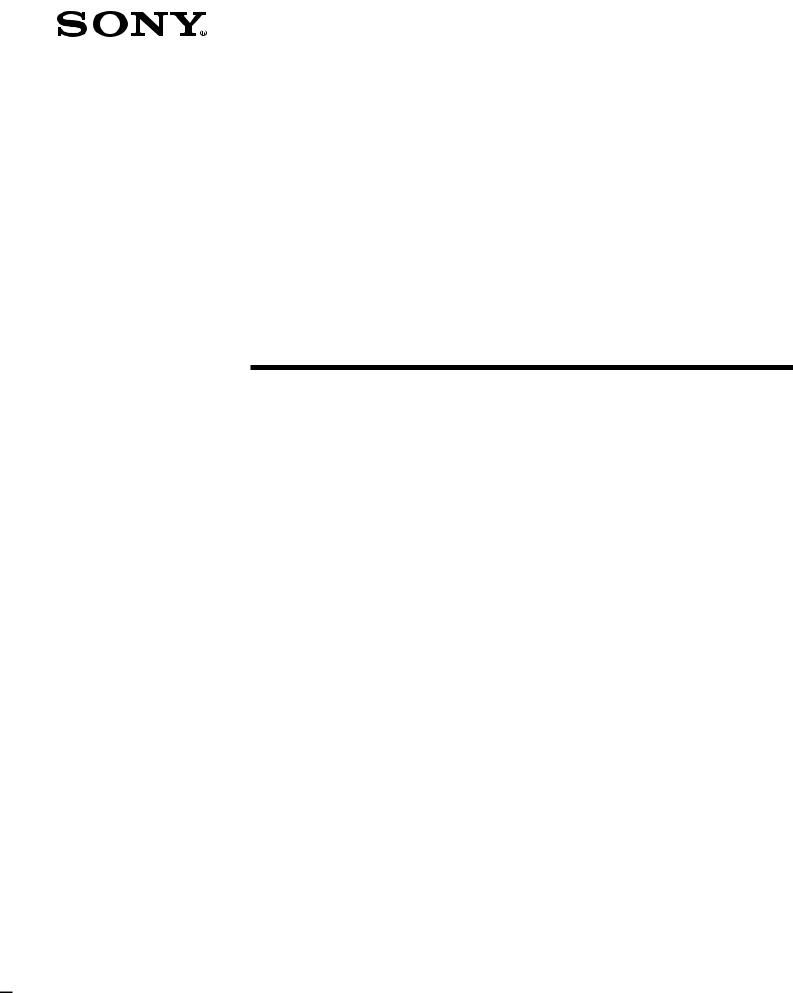
4-235-739-12(1)
FM Stereo
FM-AM Receiver
Operating Instructions
STR-DE575
STR-K502
2001 Sony Corporation
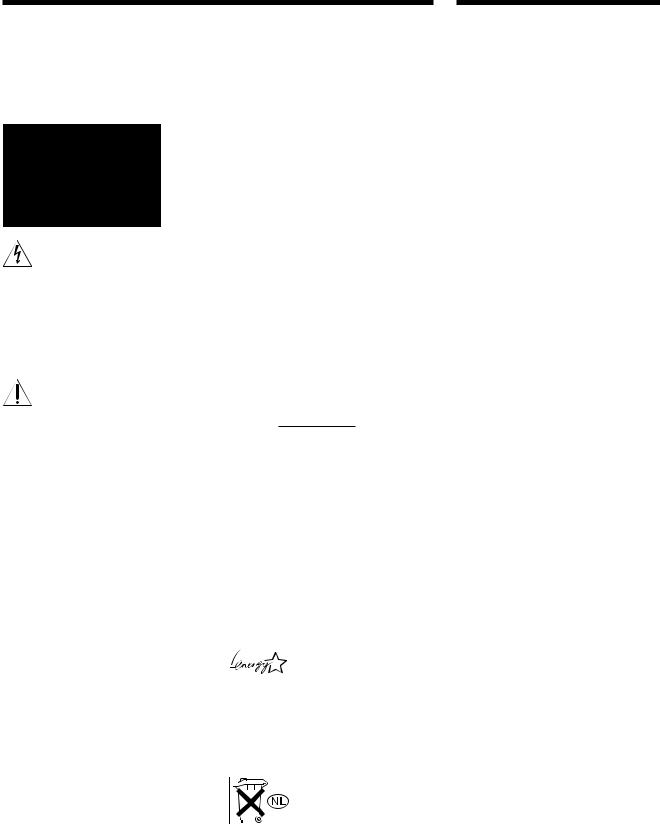
WARNING |
Precautions |
To prevent fire or shock hazard, do not expose the unit to rain or moisture.
This symbol is intended to alert the user to the presence of uninsulated “dangerous voltage” within the product’s enclosure that may be of sufficient magnitude to constitute a risk of electric shock to persons.
This symbol is intended to alert the user to the presence of important operating and maintenance (servicing) instructions in the literature accompanying the appliance.
INFORMATION
This equipment has been tested and found to comply with the limits for a Class B digital device, pursuant to Part 15 of the FCC Rules.
These limits are designed to provide reasonable protection against harmful interference in a residential installation. This equipment generates, uses, and can radiate radio frequency energy and, if not installed and used in accordance with the instructions, may cause harmful interference to radio communications. However, there is no guarantee that interference will not occur in a particular installation. If this equipment does cause harmful interference to radio or television reception, which can be determined by turning the equipment off and on, the user is encouraged to try to correct the interference by one or more of the following measures:
–Reorient or relocate the receiving antenna.
–Increase the separation between the equipment and receiver.
–Connect the equipment into an outlet on a circuit different from that to which the receiver is connected.
–Consult the dealer or an experienced radio/TV technician for help.
CAUTION
You are cautioned that any changes or modification not expressly approved in this manual could void your authority to operate this equipment.
Note to CATV system installer:
This reminder is provided to call CATV system installer’s attention to Article 82040 of the NEC that provides guidelines for proper grounding and, in particular, specifies that the cable ground shall be connected to the grounding system of the building, as close to the point of cable entry as practical.
Owner’s Record
The model and serial numbers are located on the rear of the unit. Record the serial number in the space provided below. Refer to them whenever you call upon your Sony dealer regarding this product.
Model No. STR-DE575/K502
Serial No.
For customers in Canada
CAUTION
TO PREVENT ELECTRIC SHOCK, DO NOT USE THIS POLARIZED AC PLUG WITH AN EXTENSION CORD, RECEPTACLE OR OTHER OUTLET UNLESS THE BLADES CAN BE FULLY INSERTED TO PREVENT BLADE EXPOSURE.
For customers in the United States and Canada
ENERGY STAR® is a U.S. registered mark.
As an ENERGY STAR® partner, Sony Corporation has determined that this product meets the ENERGY STAR® guidelines for energy efficiency.
Don't throw a battery, dispose it as the injurious wastes.
On safety
•Should any solid object or liquid fall into the cabinet, unplug the receiver and have it checked by qualified personnel before operating it any further.
•To prevent fire, do not cover the ventilation of the receiver with newspapers, table cloths, curtains, etc. And don’t place lighted candles on the receiver.
•To prevent fire or shock hazards, do not place vases on the receiver.
On power sources
•Before operating the receiver, check that the operating voltage is identical with your local power supply. The operating voltage is indicated on the nameplate at the rear of the receiver.
•The unit is not disconnected from the AC power source (mains) as long as it is connected to the wall outlet, even if the unit itself has been turned off.
•If you are not going to use the receiver for a long time, be sure to disconnect the receiver from the wall outlet. To disconnect the AC power cord, grasp the plug itself; never pull the cord.
•One blade of the plug is wider than the other for the purpose of safety and will fit into the wall outlet only one way. If you are unable to insert the plug fully into the outlet, contact your dealer.
•AC power cord must be changed only at the qualified service shop.
On placement
•Place the receiver in a location with adequate ventilation to prevent heat buildup and prolong the life of the receiver.
•Do not place the receiver near heat sources, or in a place subject to direct sunlight, excessive dust or mechanical shock.
•Do not place anything on top of the cabinet that might block the ventilation holes and cause malfunctions.
•Although the receiver heats up during operation, this is not a malfunction. If you continuously use this receiver at a large volume, the cabinet temperature of the top, side and bottom rises accordingly. To avoid burning yourself, do not touch the cabinet.
On operation
Before connecting other components, be sure to turn off and unplug the receiver.
On cleaning
Clean the cabinet, panel and controls with a soft cloth slightly moistened with a mild detergent solution. Do not use any type of abrasive pad, scouring powder or solvent such as alcohol or benzine.
If you have any question or problem concerning your receiver, please consult your nearest Sony dealer.
2

About This Manual
The instructions in this manual are for the STR-DE575 and STR-K502. Check your model number by looking at the lower right corner of the front panel or lower right corner of the remote. In this manual, the STR-DE575 and the remote commander RM-U305 are used for illustration purposes unless stated otherwise. Any difference in operation is clearly indicated in the text, for example, “STR-DE575 only”.
About area codes
The area code of the player you purchased is shown on the lower portion of the rear panel (see the illustration below).
ERS IMPEDANCE USE 8 – 16Ω
CENTER |
FRONT |
R L
R L
4-XXX-XXX-XX AA
Area code
Any differences in operation, according to the area code, are clearly indicate in the text, for example, “Models of area code AA only”.
Conventions
•The instructions in this manual describe the controls on the receiver. You can also use the controls on the supplied remote if they have the same or similar names as those on the receiver.
•The following icon is used in this manual:
zIndicates hints and tips for making the task easier.
This receiver incorporates Dolby* Digital and Pro Logic Surround and the DTS** Digital Surround System.
*Manufactured under license from Dolby Laboratories.
“Dolby”, “Pro Logic” and the double-D symbol aare trademarks of Dolby Laboratories.
Confidential unpublished Works. © 1992-1997 Dolby Laboratories.
All rights reserved.
**Manufactured under license from Digital Theater Systems, Inc. US Pat. No. 5,451,942, 5,956,674, 5,974,380, 5,978,762 and other world-wide patents issued and pending. “DTS” and “DTS Digital Surround” are registered trademarks of Digital Theater Systems, Inc. Copyright 1996, 2000 Digital Theater Systems, Inc. All Rights Reserved.
TABLE OF CONTENTS
Hooking Up the Components 4
Unpacking 4 |
|
Antenna Hookups 5 |
|
Audio Component Hookups |
6 |
Video Component Hookups |
7 |
Digital Component Hookups |
8 |
MULTI CH IN Hookups 9 |
|
Other Hookups 10 |
|
|
|
|
|
Hooking Up and Setting Up the
Speaker System |
11 |
|
Speaker System Hookup |
12 |
|
Performing Initial Setup Operations 14 |
||
Multi Channel Surround Setup |
15 |
|
Before You Use Your Receiver |
19 |
|
|
||
|
||
Location of Parts and Basic |
||
Operations 21 |
|
|
Front Panel Parts Descriptions |
21 |
|
|
|
|
|
|
|
Enjoying Surround Sound 25
Selecting a Sound Field 26
Understanding the Multi-Channel Surround
Displays 30
Customizing Sound Fields 32
Receiving Broadcasts 36
Direct Tuning 38
Automatic Tuning 38
Preset Tuning 39
Other Operations 40
Naming Preset Stations and Program Sources 41 Recording 41
Using the Sleep Timer 42
Adjustment Using the SET UP Button 43
Additional Information 44
Troubleshooting 44
Specifications 46
Glossary 48
Settings Using SURR, LEVEL, EQ, and SET UP
buttons 49
Remote Button Description 50
Index 58
3

Hooking Up the Components
This chapter describes how to connect various audio and video components to the receiver. Be sure to read the sections for the components you have before you actually connect them to the receiver.
Unpacking
Check that you received the following items with the receiver:
•FM wire antenna (1)
•AM loop antenna (1)
•R6 (size-AA) batteries (2)
•Models of area code U only
–Remote commander RM-U305 (remote) (1)
•Models of area code CA only
–Remote commander RM-PP505 (remote) (1)
Inserting batteries into the remote
Insert R6 (size-AA) batteries with the + and – properly oriented in the battery compartment. When using the remote, point it at the remote sensor g on the receiver.
] 
} }
]
z When to replace batteries
Under normal conditions, the batteries should last for about 6 months. When the remote no longer operates the receiver, replace all batteries with new ones.
Notes
•Do not leave the remote in an extremely hot or humid place.
•Do not use a new battery with an old one.
•Do not expose the remote sensor to direct sunlight or lighting apparatuses. Doing so may cause a malfunction.
•If you don’t use the remote for an extended period of time, remove the batteries to avoid possible damage from battery leakage and corrosion.
Before you get started
•Turn off the power to all components before making any connections.
•Do not connect the AC power cords until all of the connections are completed.
•Be sure to make connections firmly to avoid hum and noise.
•When connecting an audio/video cord, be sure to match the color-coded pins to the appropriate jacks on the components: yellow (video) to yellow; white (left, audio) to white; and red (right, audio) to red.
4
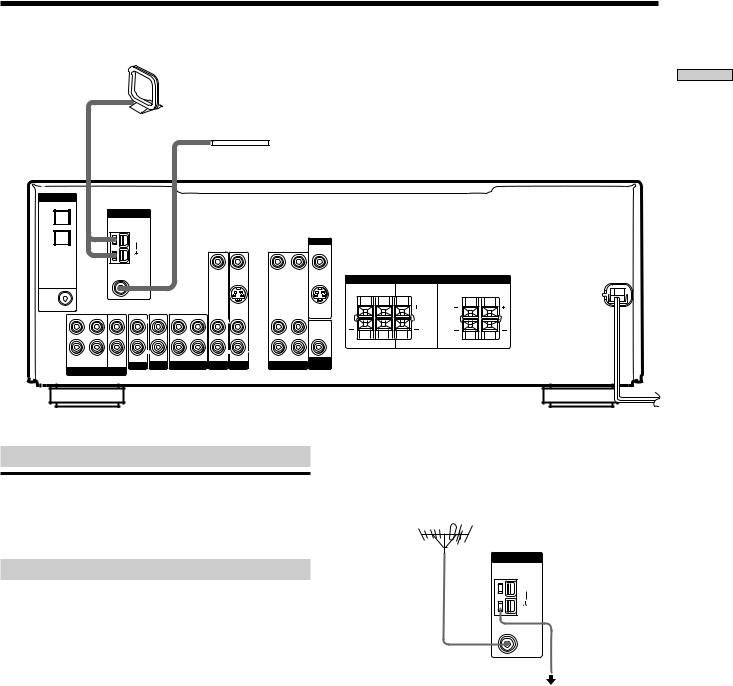
Antenna Hookups
AM loop antenna (supplied)
FM wire antenna (supplied)
DIGITAL
OPTICAL |
ANTENNA |
|
|
|
|
|
|
|
|
|
|
|
|
DVD/LD |
|
|
|
|
|
|
|
|
|
|
|
||
IN |
|
|
|
|
|
|
|
|
|
|
|
|
|
TV/SAT |
|
AM |
|
|
|
|
|
|
|
MONITOR |
|
|
|
IN |
|
|
|
|
|
|
|
|
|
|
|
||
|
|
|
|
|
|
|
|
|
|
|
|
|
|
|
|
|
|
|
|
VIDEO IN |
VIDEO IN |
VIDEO OUT |
VIDEO IN |
VIDEO OUT |
SPEAKERS IMPEDANCE USE 8 – 16Ω |
|
|
|
|
FM |
|
|
|
|
|
|
|
|
|
||
|
|
75Ω |
|
|
|
|
|
|
|
SURROUND |
CENTER |
FRONT |
|
DVD/LD |
|
COAXIAL |
|
|
|
|
|
|
|
R |
L |
R |
L |
|
|
|
|
|
|
|
|
|
|||||
IN |
|
|
|
|
|
|
|
|
|
|
|
|
|
COAXIAL |
|
|
|
|
|
|
S VIDEO |
|
|
S VIDEO |
|
|
|
|
|
|
|
|
|
|
IN |
|
|
OUT |
|
|
|
L |
|
L |
|
|
L |
|
L |
L |
|
|
|
|
|
|
|
|
|
|
|
|
|
|
AUDIO |
|
|
|
|
|
|
|
|
|
|
|
|
|
|
OUT |
|
|
|
|
CENTER |
|
|
|
|
|
|
|
|
|
|
|
|
|
|
|
|
|
|
|
|
|
|
R |
L |
R |
L |
R |
|
R |
|
|
R |
|
R |
R |
|
|
|
|
|
|
IN |
IN |
OUT |
IN |
AUDIO IN |
AUDIO IN |
AUDIO OUT |
AUDIO IN |
|
|
|
|
|
FRONT SURROUND |
SUB |
SUB |
|
|
|
||||||||
|
|
|
|
|
TV/SAT DVD/LD |
|
|
|
|
|
|||
|
WOOFER |
AUX |
CD |
MD/TAPE |
VIDEO |
WOOFER |
|
|
|
||||
MULTI CH IN |
|
|
|
||||||||||
|
|
|
|
|
|
|
|
|
|
|
|
||
Terminals for connecting the antennas
Connect the |
To the |
AM loop antenna |
AM terminals |
|
|
FM wire antenna |
FM 75Ω COAXIAL terminal |
|
|
Notes on antenna hookups
•To prevent noise pickup, keep the AM loop antenna away from the receiver and other components.
•Be sure to fully extend the FM wire antenna.
•After connecting the FM wire antenna, keep it as horizontal as possible.
z If you have poor FM reception
Use a 75-ohm coaxial cable (not supplied) to connect the receiver to an outdoor FM antenna as shown below.
Outdoor FM antenna
Receiver
ANTENNA
AM
75Ω |
Ground wire |
FM |
|
COAXIAL |
(not supplied) |
|
|
|
To ground |
Important
If you connect the receiver to an outdoor antenna, ground it against lightning. To prevent a gas explosion, do not connect the ground wire to a gas pipe.
Up Hooking Components the
5
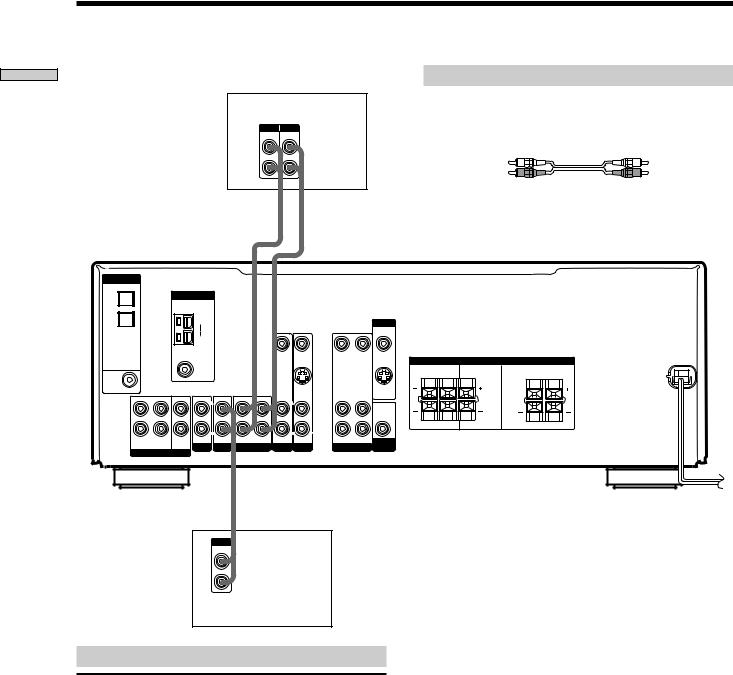
Up Hooking Components the
Audio Component Hookups
MD/TAPE deck
INPUT OUTPUT
LINE LINE
L
R
|
|
|
|
|
IN |
|
OUT |
|
|
|
|
|
|
|
|
|
ç |
|
ç |
|
|
|
|
DIGITAL |
|
|
|
|
|
|
|
|
|
|
|
OPTICAL |
ANTENNA |
|
|
|
|
|
|
|
|
||
DVD/LD |
|
|
|
|
|
|
|
|
|||
IN |
|
|
|
|
|
|
|
|
|
|
|
TV/SAT |
|
AM |
|
|
|
|
|
|
|
MONITOR |
|
IN |
|
|
|
|
|
|
|
|
|||
|
|
|
|
|
|
|
|
|
|
||
|
|
|
|
|
|
VIDEO IN |
VIDEO IN |
VIDEO OUT |
VIDEO IN |
VIDEO OUT |
|
|
|
FM |
|
|
|
|
|
|
|
|
|
|
|
75Ω |
|
|
|
|
|
|
|
|
|
DVD/LD |
|
COAXIAL |
|
|
|
|
|
|
|
|
|
IN |
|
|
|
|
|
|
|
|
|
|
|
COAXIAL |
|
|
|
|
|
|
S VIDEO |
|
|
S VIDEO |
|
|
|
|
|
|
|
|
IN |
|
|
OUT |
|
L |
|
L |
|
|
L |
|
L |
L |
|
|
|
|
|
|
|
|
|
|
|
|
AUDIO |
||
|
|
|
|
|
|
|
|
|
|
OUT |
|
|
CENTER |
|
|
|
|
|
|
|
|
|
|
R |
|
R |
|
|
R |
|
R |
R |
|
|
|
|
IN |
IN |
OUT |
IN |
AUDIO IN |
AUDIO IN |
AUDIO OUT |
AUDIO IN |
|
||
FRONT SURROUND |
SUB |
SUB |
|||||||||
|
|
|
|
|
TV/SAT DVD/LD |
|
|
||||
|
WOOFER |
AUX |
CD |
MD/TAPE |
VIDEO |
WOOFER |
|||||
MULTI CH IN |
|||||||||||
|
|
|
|
|
|
|
|
|
|||
OUTPUT
LINE
L
R
CD player
Jacks for connecting audio components
Connect a |
To the |
|
|
CD player |
CD jacks |
|
|
MD deck or Tape deck |
MD/TAPE jacks |
|
|
Required cords
Audio cords (not supplied)
When connecting a cord, be sure to match the color-coded pins to the appropriate jacks on the components.
White (L) |
White (L) |
Red (R) |
Red (R) |
SPEAKERS IMPEDANCE USE 8 – 16Ω
SURROUND |
CENTER |
|
FRONT |
|
R |
L |
|
R |
L |
R |
L |
|
R |
L |
6
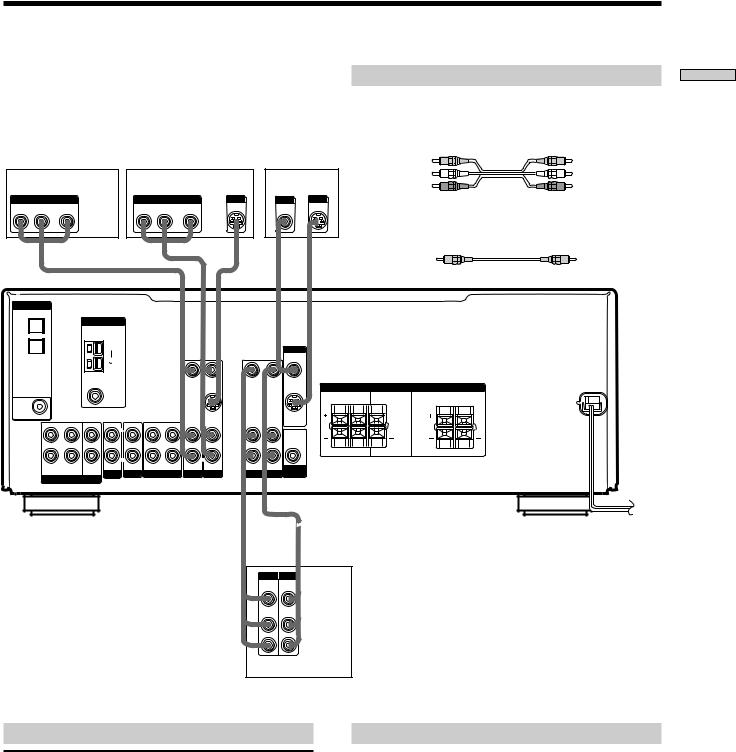
Video Component Hookups
|
|
|
|
|
|
|
Required cords |
|
|
|
|
|
|
|
|
Audio/video cords (not supplied) |
|
|
|
|
|
|
|
|
When connecting a cord, be sure to match the color-coded pins to |
|
|
|
|
|
|
|
|
the appropriate jacks on the components. |
|
|
|
|
|
|
|
|
Yellow (video) |
Yellow (video) |
TV or satellite tuner |
DVD or LD player |
TV monitor |
White (L/audio) |
White (L/audio) |
||||
|
|
|||||||
OUTPUT |
|
OUTPUT |
|
* S-VIDEO |
INPUT |
* S-VIDEO |
Red (R/audio) |
Red (R/audio) |
AUDIO OUT |
VIDEO |
AUDIO OUT |
VIDEO |
OUT |
VIDEO |
IN |
|
|
R L |
OUT |
R L |
OUT |
|
IN |
|
|
|
Video cord for connecting a TV monitor (not supplied)
Yellow |
Yellow |
DIGITAL
OPTICAL |
ANTENNA |
|
DVD/LD |
|
|
IN |
|
|
TV/SAT |
AM |
MONITOR |
IN |
||
|
|
|
|
VIDEO IN VIDEO IN |
VIDEO OUT VIDEO IN VIDEO OUT |
|
|
|
FM |
|
|
|
|
|
|
|
SPEAKERS IMPEDANCE USE 8 – 16Ω |
|
|
|
|
|
75Ω |
|
|
|
|
|
|
SURROUND |
CENTER |
FRONT |
|
DVD/LD |
|
|
COAXIAL |
|
|
|
|
|
|
R |
L |
R |
L |
IN |
|
|
|
|
|
|
|
|
|
|
|
|
|
COAXIAL |
|
|
|
|
|
|
|
S VIDEO |
|
S VIDEO |
|
|
|
|
|
|
|
|
|
|
|
IN |
|
OUT |
|
|
|
|
L |
|
L |
|
|
L |
|
L |
L |
|
|
|
|
|
|
|
|
|
|
|
|
|
AUDIO |
|
|
|
|
|
|
|
|
|
|
|
|
|
|
OUT |
|
|
|
|
|
CENTER |
|
|
|
|
|
|
|
|
|
|
|
|
|
|
|
|
|
|
|
|
|
R |
L |
R |
L |
|
R |
|
R |
|
|
R |
|
R |
R |
|
|
|
|
|
|
IN |
IN |
OUT |
IN |
AUDIO IN |
AUDIO IN |
AUDIO OUT AUDIO IN |
|
|
|
|
|
FRONT |
SURROUND |
SUB |
SUB |
|
|
|
|||||||
|
|
|
|
|
|
TV/SAT DVD/LD |
|
|
|
|
|||
|
|
WOOFER |
AUX |
CD |
MD/TAPE |
VIDEO |
WOOFER |
|
|
|
|||
MULTI CH IN |
|
|
|
||||||||||
|
|
|
|
|
|
|
|
|
|
|
|||
|
|
|
|
|
|
|
|
|
ç |
ç |
|
|
|
|
|
|
|
|
|
|
|
|
IN |
OUT |
|
|
|
|
|
|
|
|
|
|
|
|
INPUT OUTPUT |
|
|
|
|
|
|
|
|
|
|
|
|
|
VIDEO |
VIDEO |
|
|
|
|
|
|
|
|
|
|
|
|
IN |
OUT |
|
|
|
|
|
|
|
|
|
|
|
|
AUDIO |
AUDIO |
|
|
|
|
|
|
|
|
|
|
|
|
IN |
OUT |
|
|
|
|
|
|
|
|
|
|
|
|
|
L |
|
|
|
|
|
|
|
|
|
|
|
|
|
R |
|
|
|
|
|
|
|
|
|
|
|
|
|
VCR |
|
|
|
* STR-DE575 only.
Jacks for connecting video components
Connect a |
To the |
TV or satellite tuner |
TV/SAT jacks |
|
|
VCR |
VIDEO jacks |
|
|
DVD or LD player |
DVD/LD jacks |
|
|
TV monitor |
MONITOR VIDEO OUT jack |
|
|
Note on video component hookups
You can connect your TV’s audio output jacks to the TV/ SAT AUDIO IN jacks on the receiver and apply sound effects to the audio from the TV. In this case, do not connect the TV’s video output jack to the TV/SAT VIDEO IN jack on the receiver. If you are connecting a separate TV tuner (or satellite tuner), connect both the audio and video output jacks to the receiver as shown above.
z When using the S-video jacks instead of the video jacks
Your monitor must also be connected via an S-video jack. S-video signals are on a separate bus from the video signals and will not be output through the video jacks. (STR-DE575 only)
Up Hooking Components the
7
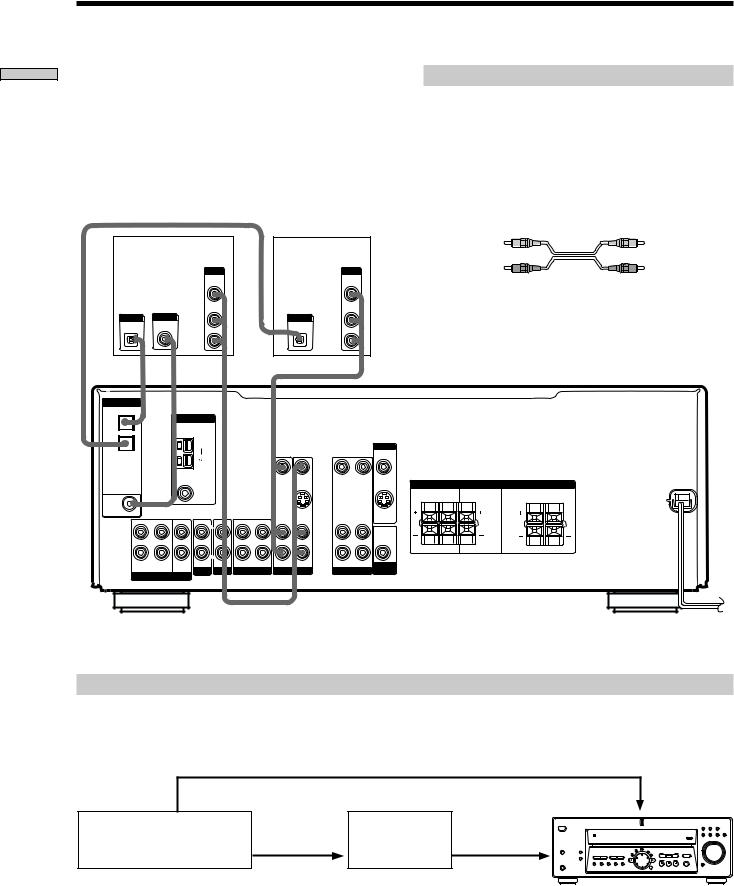
Up Hooking Components the
Digital Component Hookups
Connect the digital output jacks of your DVD player and satellite tuner (etc.) to the receiver’s digital input jacks to bring the multi channel surround sound of a movie theater into your home. To enjoy full effect of multi channel surround sound, five speakers (two front speakers, two surround speakers, and a center speaker) and a sub woofer are required. You can also connect an LD player with an RF OUT jack via an RF demodulator, such as the Sony MOD-RF1 (not supplied).
|
DVD or LD |
|
TV or Satellite |
|
player (etc.)* |
|
tuner |
||
|
OUTPUT |
|
OUTPUT |
|
|
VIDEO |
|
VIDEO |
|
|
OUT |
|
OUT |
|
|
AUDIO |
|
AUDIO |
|
|
OUT |
|
OUT |
|
OUTPUT |
OUTPUT |
L |
OUTPUT |
|
DIGITAL |
DIGITAL |
DIGITAL |
||
|
||||
OPTICAL |
COAXIAL |
|
OPTICAL |
|
|
|
R |
|
|
DIGITAL
OPTICAL |
ANTENNA |
|
|
|
|
|
|
|
|
||
DVD/LD |
|
|
|
|
|
|
|
|
|||
IN |
|
|
|
|
|
|
|
|
|
|
|
TV/SAT |
|
AM |
|
|
|
|
|
|
|
MONITOR |
|
IN |
|
|
|
|
|
|
|
|
|||
|
|
|
|
|
|
|
|
|
|
||
|
|
|
|
|
|
VIDEO IN |
VIDEO IN |
VIDEO OUT |
VIDEO IN |
VIDEO OUT |
|
|
|
FM |
|
|
|
|
|
|
|
|
|
|
|
75Ω |
|
|
|
|
|
|
|
|
|
DVD/LD |
|
COAXIAL |
|
|
|
|
|
|
|
|
|
IN |
|
|
|
|
|
|
|
|
|
|
|
COAXIAL |
|
|
|
|
|
|
S VIDEO |
|
|
S VIDEO |
|
|
|
|
|
|
|
|
IN |
|
|
OUT |
|
L |
|
L |
|
|
L |
|
L |
L |
|
|
|
|
|
|
|
|
|
|
|
|
AUDIO |
||
|
|
|
|
|
|
|
|
|
|
OUT |
|
|
CENTER |
|
|
|
|
|
|
|
|
|
|
R |
|
R |
|
|
R |
|
R |
R |
|
|
|
|
IN |
IN |
OUT |
IN |
AUDIO IN |
AUDIO IN |
AUDIO OUT |
AUDIO IN |
|
||
FRONT SURROUND |
SUB |
SUB |
|||||||||
|
|
|
|
|
TV/SAT DVD/LD |
|
|
||||
|
WOOFER |
AUX |
CD |
MD/TAPE |
VIDEO |
WOOFER |
|||||
MULTI CH IN |
|||||||||||
|
|
|
|
|
|
|
|
|
|||
Required cords
Optical digital cords (not supplied)
Black 
 Black
Black
Coaxial digital cord (not supplied)
Yellow 
 Yellow
Yellow
Audio/video cords (not supplied)
When connecting a cord, be sure to match the color-coded pins to the appropriate jacks on the components.
Yellow (video) |
Yellow (video) |
White (L/audio)
 White (L/audio)
White (L/audio)
Red (R/audio) |
Red (R/audio) |
Note
The optical and coaxial digital input jacks on the receiver are compatible with sampling frequencies of 32 kHz, 44.1 kHz, 48kHz and 96kHz** (**DVD/LD only).
SPEAKERS IMPEDANCE USE 8 – 16Ω
SURROUND |
CENTER |
|
FRONT |
|
R |
L |
|
R |
L |
R |
L |
|
R |
L |
*When making digital audio connections to a DVD player, connect to either the coaxial OR optical digital jacks, and not both. It is recommended to make digital audio connections to the coaxial jack.
Example of LD player connected via an RF demodulator
Please note that you cannot connect an LD player’s DOLBY DIGITAL RF OUT jack directly to the receiver’s digital input jacks. You must first convert the RF signal to either an optical or coaxial digital signal. Connect the LD player to the RF demodulator, then connect the RF demodulator’s optical or coaxial digital output to the receiver’s OPTICAL or COAXIAL DVD/LD IN jack. Refer to the instruction manual supplied with your RF Demodulator for details on DOLBY DIGITAL RF hookups.
|
|
|
|
|
DVD/LD |
|
|
|
||
VIDEO OUT |
|
|
DIGITAL |
|
VIDEO IN |
|
|
|
||
|
|
|
|
|
|
|
|
|
|
|
|
|
|
DVD/LD IN |
? / 1 |
|
|
|
|
|
MD/TAPE CD TUNER AUX |
|
|
|
|
|
|
|
MULTI CHANNEL DECODING |
|
VIDEO DVD/LD TV/SAT |
|
LD player |
DOLBY DIGITAL |
RF demodulator |
(COAXIAL) |
|
|
|
|
|
|
MASTER VOLUME |
|
|
|
|
|
|
|
+ |
|||
|
|
|
|
|
|
|
|
|
|
INPUT MODE |
|
RF OUT |
|
or (OPTICAL) |
SPEAKERS DISPLAY |
|
|
SURR LEVEL |
SET UP |
CINEMA STUDIO EX |
– |
|
|
|
|
|
PRESET |
|
EQ |
NAME |
EQUALIZER |
|
|
|
|
|
DIMMER |
– TUNING + – TUNING + |
|
A |
B |
C |
|
|
|
|
|
|
MEMORY SHIFT FM MODE FM |
AM |
|
|
SOUND FIELD |
MULTI CH IN |
|
|
|
|
|
|
|
|
MUTING |
||
|
|
|
|
PHONES |
|
|
|
A.F.D. MODE |
2CH |
|
|
|
|
|
|
|
|
|
ENTER |
|
|
Note
When making connections as shown above, be sure to set INPUT MODE (8on page 23) manually. The receiver may not operate correctly if INPUT MODE is set to “AUTO.”
8

MULTI CH IN Hookups
Although this receiver incorporates a multi channel decoder, it is also equipped with MULTI CH IN jacks. These connections allow you to enjoy multichannel software encoded in formats other than Dolby Digital and DTS. If your DVD player is equipped with MULTI CH OUTPUT jacks, you can connect them directly to the receiver to enjoy the sound of the DVD player’s multi channel decoder. Alternatively, the MULTI CH IN jacks can be used to connect an external multi channel decoder. To fully enjoy multi channel surround sound, you will need five speakers (two front speakers, two surround speakers, and a center speaker) and a sub woofer. Refer to the instruction manual supplied with your DVD player, multi channel decoder, etc., for details on the multi channel input hookups.
DVD player,
Multichannel decoder, etc.
MULTI CH OUTPUT
SURROUND FRONT
|
CENTER |
|
|
|
|
|
|
|
|
||
|
SUB |
|
|
|
|
|
|
|
|
|
|
|
WOOFER |
|
|
|
|
|
|
|
|
||
DIGITAL |
|
|
|
|
|
|
|
|
|
|
|
OPTICAL |
ANTENNA |
|
|
|
|
|
|
|
|
||
DVD/LD |
|
|
|
|
|
|
|
|
|||
IN |
|
|
|
|
|
|
|
|
|
|
|
TV/SAT |
|
AM |
|
|
|
|
|
|
|
MONITOR |
|
IN |
|
|
|
|
|
|
|
|
|||
|
|
|
|
|
|
|
|
|
|
||
|
|
|
|
|
|
VIDEO IN |
VIDEO IN |
VIDEO OUT |
VIDEO IN |
VIDEO OUT |
|
|
|
FM |
|
|
|
|
|
|
|
|
|
|
|
75Ω |
|
|
|
|
|
|
|
|
|
DVD/LD |
|
COAXIAL |
|
|
|
|
|
|
|
|
|
IN |
|
|
|
|
|
|
|
|
|
|
|
COAXIAL |
|
|
|
|
|
|
S VIDEO |
|
|
S VIDEO |
|
|
|
|
|
|
|
|
IN |
|
|
OUT |
|
L |
|
L |
|
|
L |
|
L |
L |
|
|
|
|
|
|
|
|
|
|
|
|
AUDIO |
||
|
|
|
|
|
|
|
|
|
|
OUT |
|
|
CENTER |
|
|
|
|
|
|
|
|
|
|
R |
|
R |
|
|
R |
|
R |
R |
|
|
|
|
IN |
IN |
OUT |
IN |
AUDIO IN |
AUDIO IN |
AUDIO OUT |
AUDIO IN |
|
||
FRONT SURROUND |
SUB |
SUB |
|||||||||
|
|
|
|
|
TV/SAT DVD/LD |
|
|
||||
|
WOOFER |
AUX |
CD |
MD/TAPE |
VIDEO |
WOOFER |
|||||
MULTI CH IN |
|||||||||||
|
|
|
|
|
|
|
|
|
|||
Required cords
Audio cords (not supplied)
Two for the MULTI CH IN FRONT and SURROUND jacks
White (L) |
White (L) |
Red (R) |
Red (R) |
Monaural audio cords (not supplied)
Two for the MULTI CH IN CENTER and SUB WOOFER jacks
Black 
 Black
Black
Video cord (not supplied)
One for the DVD/LD VIDEO IN jacks (etc.)
Yellow 
 Yellow
Yellow
Note
When using the connections described below, adjust the level of your surround speakers and sub woofer from the DVD player or multichannel decoder.
SPEAKERS IMPEDANCE USE 8 – 16Ω
SURROUND |
CENTER |
|
FRONT |
|
R |
L |
|
R |
L |
R |
L |
|
R |
L |
Example of a DVD player hookup using the MULTI CH IN jacks
VIDEO OUT |
MULTI CH IN |
|
? / 1 |
DVD player |
SPEAKERS DISPLAY |
|
DIMMER |
|
PHONES |
Note
See page 12 for details on speaker system hookup.
|
|
|
|
|
|
|
|
Front Speaker (L) |
|
|
|
|
|
|
|
|
Front Speaker (R) |
|
|
|
|
DVD/LD |
SPEAKERS |
Surround Speaker (L) |
||
|
|
|
|
IN VIDEO etc. |
||||
|
|
|
|
|
|
|
FRONT |
Surround Speaker (R) |
|
|
|
|
|
|
MD/TAPE CD TUNER AUX |
|
|
|
|
|
MULTI CHANNEL DECODING |
|
VIDEO DVD/LD TV/SAT |
SPEAKERS |
|
|
|
|
|
|
|
|
+ |
|
|
|
|
|
|
|
|
INPUT MODE |
|
|
|
|
|
|
|
|
MASTER VOLUME |
SURROUND/CENTER |
|
|
|
|
|
SET UP |
|
– |
|
|
|
|
|
|
LEVEL |
|
|
|
Center Speaker |
|
|
|
SURR |
|
|
|
|
|
|
|
|
|
|
SOUND FIELD |
MULTI CH IN |
|
|
PRESET |
|
EQ |
|
NAME |
CINEMA STUDIO EX |
EQUALIZER |
|
|
– TUNING + – TUNING + |
|
|
A |
B |
C |
SUB WOOFER |
|
|
MEMORY SHIFT FM MODE FM |
AM |
|
|
|
|
MUTING |
|
|
|
|
|
|
A.F.D. MODE |
2CH |
|
|
|
|
|
|
|
ENTER |
|
|
|
|
Active Woofer
Up Hooking Components the
9
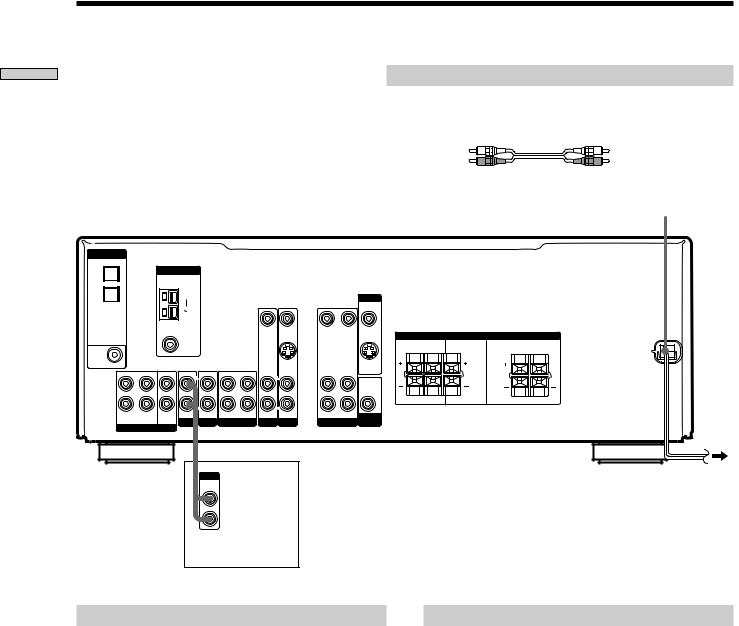
Up Hooking Components the
Other Hookups
Required cords
Audio cords (not supplied)
When connecting a cord, be sure to match the color-coded pins to the appropriate jacks on the components.
White (L)
Red (R)
DIGITAL
OPTICAL |
ANTENNA |
|
|
|
|
|
|
|
|
||
DVD/LD |
|
|
|
|
|
|
|
|
|||
IN |
|
|
|
|
|
|
|
|
|
|
|
TV/SAT |
|
AM |
|
|
|
|
|
|
|
MONITOR |
|
IN |
|
|
|
|
|
|
|
|
|||
|
|
|
|
|
|
|
|
|
|
||
|
|
|
|
|
|
VIDEO IN |
VIDEO IN |
VIDEO OUT |
VIDEO IN |
VIDEO OUT |
|
|
|
FM |
|
|
|
|
|
|
|
|
|
|
|
75Ω |
|
|
|
|
|
|
|
|
|
DVD/LD |
|
COAXIAL |
|
|
|
|
|
|
|
|
|
IN |
|
|
|
|
|
|
|
|
|
|
|
COAXIAL |
|
|
|
|
|
|
S VIDEO |
|
|
S VIDEO |
|
|
|
|
|
|
|
|
IN |
|
|
OUT |
|
L |
|
L |
|
|
L |
|
L |
L |
|
|
|
|
|
|
|
|
|
|
|
|
AUDIO |
||
|
|
|
|
|
|
|
|
|
|
OUT |
|
|
CENTER |
|
|
|
|
|
|
|
|
|
|
R |
|
R |
|
|
R |
|
R |
R |
|
|
|
|
IN |
IN |
OUT |
IN |
AUDIO IN |
AUDIO IN |
AUDIO OUT |
AUDIO IN |
|
||
FRONT SURROUND |
SUB |
SUB |
|||||||||
|
|
|
|
|
TV/SAT DVD/LD |
|
|
||||
|
WOOFER |
AUX |
CD |
MD/TAPE |
VIDEO |
WOOFER |
|||||
MULTI CH IN |
|||||||||||
|
|
|
|
|
|
|
|
|
|||
SPEAKERS IMPEDANCE USE 8 – 16Ω
SURROUND |
CENTER |
|
FRONT |
|
R |
L |
|
R |
L |
R L R L
White (L)
Red (R)
AC power cord
OUTPUT |
To a wall outlet |
|
|
LINE |
|
CD player, tape deck,
MD deck, etc.
AUX AUDIO IN hookup
•If you have an individual audio component (except PHONO)
Use the audio cords to connect the LINE OUT jacks on the CD player, tape deck, or MD deck to the AUX AUDIO IN jack on the receiver so that you can listen to stereo sources in surround sound.
Connecting the AC power cord
Before connecting the AC power cord of this receiver to a wall outlet:
•Connect the speaker system to the receiver (see page 12).
Connect the AC power cord(s) of your audio/video components to a wall outlet.
Note
If the AC power cord is disconnected for about one week, the receiver’s entire memory will be cleared and the demonstration will start.
10
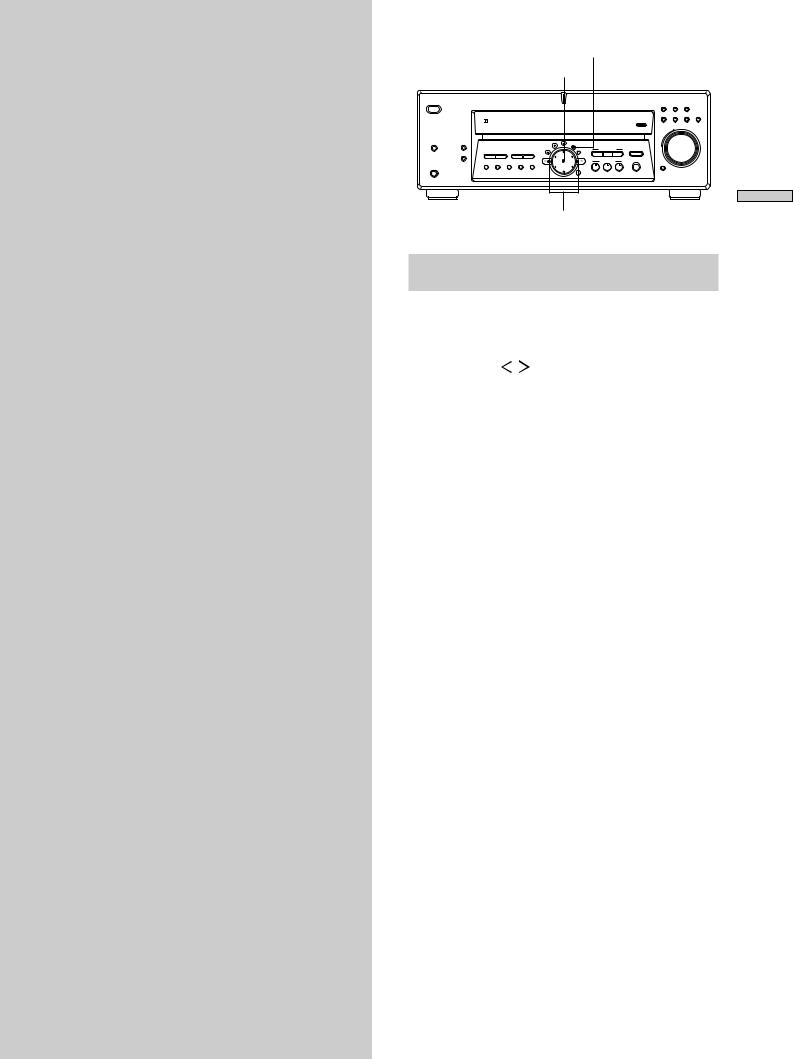
Hooking Up
and Setting Up
the Speaker
System
This chapter describes how to hook up your speaker system to the receiver, how to position each speaker, and how to set up your speakers to enjoy multi channel surround sound.
|
|
|
|
|
|
|
|
|
|
SET UP |
|
|
|
|
|
|
|
|
|
|
|
|
|
Jog dial |
|
|
|
|
|
||
? / 1 |
|
|
|
|
|
|
|
|
MULTI CHANNEL DECODING |
|
VIDEO |
DVD/LD |
TV/SAT |
|
|
|
|
|
|
|
|
|
|
|
|
|
|
|
|
|
|
|
|
|
|
|
|
|
|
|
|
|
|
MD/TAPE |
CD |
TUNER |
AUX |
|
|
|
|
|
|
|
|
|
|
|
|
INPUT MODE |
|
|
|
|
|
|
|
|
|
|
|
|
|
|
|
|
MASTER VOLUME |
|
|
|
|
|
|
|
|
|
|
|
|
|
|
|
+ |
|
|
SPEAKERS |
DISPLAY |
|
|
|
|
|
|
|
|
LEVEL |
|
|
|
|
|
|
|
|
|
|
|
|
SURR |
SET UP |
|
|
|
|
|
||
|
|
|
|
|
|
|
|
|
|
|
– |
|
|
|
|
|
|
|
PRESET |
|
|
|
|
EQ |
|
NAME |
CINEMA STUDIO EX |
EQUALIZER |
|
|
|
|
|
– |
+ |
– |
|
+ |
|
|
|
|
|
|
|||
|
DIMMER |
TUNING |
TUNING |
|
|
A |
B |
C |
|
|
|
||||
|
|
MEMORY |
SHIFT |
FM MODE |
FM |
AM |
|
|
|
SOUND FIELD |
MULTI CH IN |
|
|
|
|
|
|
|
|
|
|
MUTING |
|
|
|
||||||
PHONES |
|
|
|
|
|
|
|
|
|
A.F.D. |
MODE |
2CH |
|
|
|
|
|
|
|
|
|
|
|
|
|
ENTER |
|
|
|
|
|
Cursor buttons
Brief descriptions of buttons and control
used to set up the speaker system
SET UP button: Press to enter the setup mode when specifying speaker types and distances.
Cursor buttons ( / ): Use to select parameters after pressing the SET UP button.
Jog dial: Use to adjust the setting of each parameter.
Up Hooking
Setting and the Up System Speaker
11
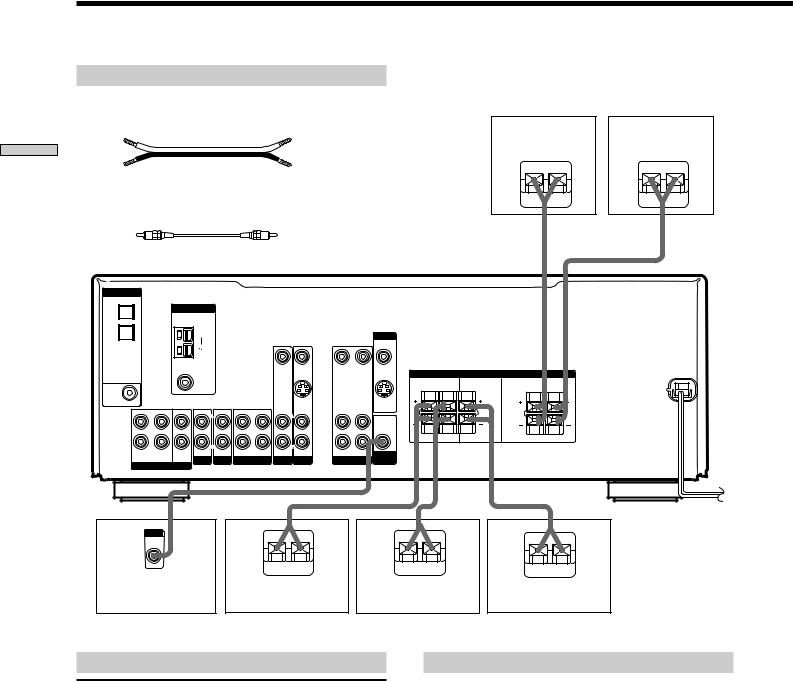
Up Hooking
Setting and the Up System Speaker
Speaker System Hookup
Required cords
Speaker cords (not supplied)
One for each front, surround, and center speaker
(+) |
|
|
|
|
|
(+) |
|
|
|
|
Front speaker (R) |
Front speaker (L) |
||
|
|
|
|
|
|
|
|
|
|
|
|
|
||
(–) |
|
|
|
|
|
(–) |
|
|
|
|
|
|
|
|
Monaural audio cord (not supplied) |
|
|
|
|
|
|
} |
] |
} |
] |
||||
|
|
|
|
|
|
|
|
|
|
|||||
One for an active woofer |
|
|
|
|
|
|
|
|
|
|
|
|
|
|
Black |
|
|
|
|
|
Black |
|
|
|
|
|
|
|
|
DIGITAL |
|
|
|
|
|
|
|
|
|
|
|
|
|
|
OPTICAL |
ANTENNA |
|
|
|
|
|
|
|
|
|
|
|
|
|
DVD/LD |
|
|
|
|
|
|
|
|
|
|
|
|
||
IN |
|
|
|
|
|
|
|
|
|
|
|
|
|
|
TV/SAT |
|
AM |
|
|
|
|
|
|
MONITOR |
|
|
|
|
|
IN |
|
|
|
|
|
|
|
|
|
|
|
|
||
|
|
|
|
|
|
|
|
|
|
|
|
|
|
|
|
|
|
|
|
VIDEO IN |
VIDEO IN |
VIDEO OUT |
VIDEO IN |
VIDEO OUT |
SPEAKERS IMPEDANCE USE 8 – 16Ω |
|
|
|
|
|
|
FM |
|
|
|
|
|
|
|
|
|
|
||
|
|
|
|
|
|
|
|
|
|
|
|
|
|
|
|
|
75Ω |
|
|
|
|
|
|
SURROUND |
CENTER |
FRONT |
|
|
|
DVD/LD |
|
COAXIAL |
|
|
|
|
|
|
R |
L |
R |
L |
|
|
IN |
|
|
|
|
|
|
|
|
|
|
|
|
|
|
COAXIAL |
|
|
|
|
|
S VIDEO |
|
|
S VIDEO |
|
|
|
|
|
|
|
|
|
|
|
|
|
|
|
|
|
|
||
|
|
|
|
|
|
IN |
|
|
OUT |
|
|
|
|
|
L |
|
L |
|
L |
|
L |
L |
|
|
|
|
|
|
|
|
|
|
|
|
|
|
|
AUDIO |
|
|
|
|
|
|
|
|
|
|
|
|
|
|
|
OUT |
|
|
|
|
|
|
CENTER |
|
|
|
|
|
|
|
|
|
|
|
|
|
|
|
|
|
|
|
|
|
|
R |
L |
R |
L |
|
|
R |
|
R |
|
R |
|
R |
R |
|
|
|
|
|
|
|
|
IN |
IN |
OUT IN |
AUDIO IN |
AUDIO IN |
AUDIO OUT |
AUDIO IN |
|
|
|
|
|
|
|
FRONT SURROUND |
SUB |
SUB |
|
|
|
|
|
|||||||
|
|
|
|
TV/SAT DVD/LD |
|
|
|
|
|
|
|
|||
|
WOOFER |
AUX |
CD |
MD/TAPE |
VIDEO |
WOOFER |
|
|
|
|
|
|||
MULTI CH IN |
|
|
|
|
|
|||||||||
|
|
|
|
|
|
|
|
|
|
|
|
|
||
INPUT |
|
|
|
|
|
|
AUDIO |
} |
] |
} |
] |
} |
] |
IN |
||||||
Active sub woofer |
Surround speaker (R) |
Surround speaker (L) |
Center speaker |
|||
Terminals for connecting the speakers
Connect the |
To the |
|
|
Front speakers (8 ohm) |
SPEAKERS FRONT terminals |
|
|
Surround speakers (8 ohm) |
SPEAKERS SURROUND terminals |
|
|
Center speaker (8 ohm) |
SPEAKERS CENTER terminals |
|
|
Active sub woofer |
SUB WOOFER AUDIO OUT jack |
|
|
Notes on speaker system hookup
•Twist the stripped ends of the speaker cords about 2/3 inch (10 mm). Be sure to match the speaker cord to the appropriate terminal on the components: + to + and – to –. If the cords are reversed, the sound will be distorted and will lack bass.
•If you use speakers with low maximum input rating, adjust the volume carefully to avoid excessive output on the speakers.
12

To avoid short-circuiting the speakers
Short-circuiting of the speakers may damage the receiver. To prevent this, make sure to take the following precautions when connecting the speakers.
Make sure the stripped ends of each speaker cord does not touch another speaker terminal or the stripped end of another speaker cord.
Examples of poor conditions of the speaker cord
Stripped speaker cord is touching another speaker terminal.
Stripped cords are touching each other due to excessive removal of insulation.
After connecting all the components, speakers, and AC power cord, output a test tone to check that all the speakers are connected correctly. For details on outputting a test tone, see page 18.
If no sound is heard from a speaker while outputting a test tone or a test tone is output from a speaker other than the one whose name is currently displayed on the receiver, the speaker may be short-circuited. If this happens, check the speaker connection again.
To avoid damaging your speakers
Make sure that you turn down the volume before you turn off the receiver. When you turn on the receiver, the volume remains at the level you turn off the receiver.
Up Hooking
Setting and the Up System Speaker
13
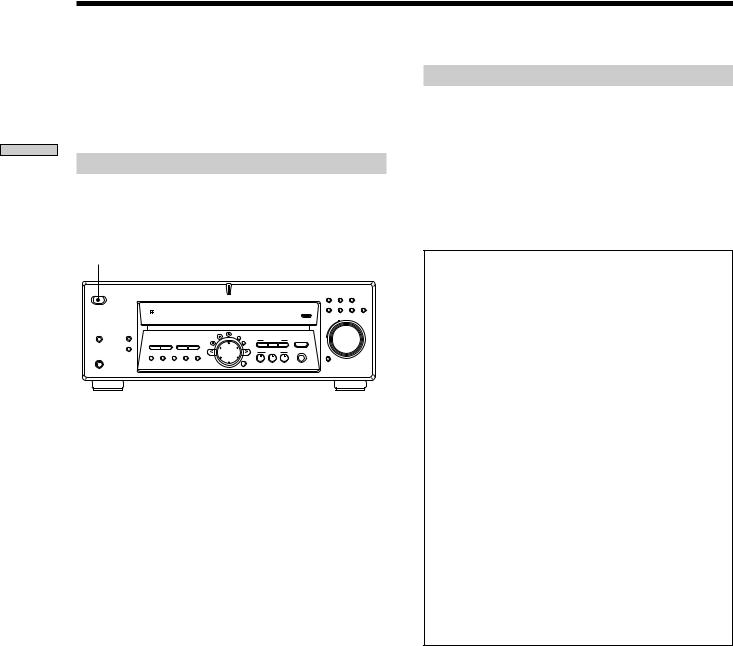
Up Hooking
Setting and the Up System Speaker
Performing Initial Setup Operations
Once you have hooked up the speakers and turned on the power, clear the receiver’s memory. Then specify the speaker parameters (size, position, etc.) and perform any other initial setup operations necessary for your system.
Clearing the receiver’s memory
Before you use your receiver for the first time or when you want to clear the receiver’s memory, do the following. This procedure is not necessary if the demonstration activates when you turn the power on.
1/u
? / 1 |
|
|
|
|
|
|
|
|
MULTI CHANNEL DECODING |
|
VIDEO |
DVD/LD |
TV/SAT |
|
|
|
|
|
|
|
|
|
|
|
|
|
|
|
|
|
|
|
|
|
|
|
|
|
|
|
|
|
|
MD/TAPE |
CD |
TUNER |
AUX |
|
|
|
|
|
|
|
|
|
|
|
|
INPUT MODE |
|
|
|
|
|
|
|
|
|
|
|
|
|
|
|
|
MASTER VOLUME |
|
|
|
|
|
|
|
|
|
|
|
|
|
|
|
+ |
|
|
SPEAKERS |
DISPLAY |
|
|
|
|
|
|
|
|
LEVEL |
|
|
|
|
|
|
|
|
|
|
|
|
SURR |
SET UP |
|
|
|
|
|
||
|
|
|
|
|
|
|
|
|
|
|
– |
|
|
|
|
|
|
|
PRESET |
|
|
|
|
EQ |
|
NAME |
CINEMA STUDIO EX |
EQUALIZER |
|
|
|
|
|
– |
+ |
– |
|
+ |
|
|
|
|
|
|
|||
|
DIMMER |
TUNING |
TUNING |
|
|
A |
B |
C |
|
|
|
||||
|
|
MEMORY |
SHIFT |
FM MODE |
FM |
AM |
|
|
|
SOUND FIELD |
MULTI CH IN |
|
|
|
|
|
|
|
|
|
|
MUTING |
|
|
|
||||||
PHONES |
|
|
|
|
|
|
|
|
|
A.F.D. |
MODE |
2CH |
|
|
|
|
|
|
|
|
|
|
|
|
|
ENTER |
|
|
|
|
|
1Turn off the receiver.
2Hold down ?/1 for four seconds.
The currently selected function, then the demonstration message appears in the display and the items including the following are reset or cleared:
•All preset stations are reset or cleared.
•All sound field parameters are reset to their factory settings.
•All index names (of preset stations and program sources) are cleared.
•All adjustments made with the SET UP button are reset to their factory settings.
•The sound field memorized for each program source and preset stations are cleared.
Performing initial setup operations
Before you use your receiver for the first time, use the SET UP button to adjust settings to correspond to your system. You can set the following items. For details on how to adjust each setting, see the page in parentheses.
•Speaker size and placement (page 15).
•Speaker distance (page 17).
•Select the MULTI CH IN video signal (page 43).
•Whether the display turns off or not when you press DIMMER (page 43).
Demonstration Mode
The demonstration will activate the first time you turn on the power. When the demonstration starts, the following message appears in the display:
“NOW DEMONSTRATION MODE IF YOU FINISH DEMONSTRATION PLEASE PRESS POWER KEY WHILE THIS MESSAGE APPEARS IN THE DISPLAY THANK YOU”
To cancel the demonstration
Press ?/1 to turn the receiver off while the above message is being displayed. The next time you turn the receiver on, the demonstration will not appear.
To view the demonstration
Hold down SET UP and press ?/1 to turn on the power.
Notes
•Running the demonstration will clear the receiver’s memory. For details on what will be cleared, see “Clearing the receiver's memory” on this page.
•There will be no sound when the demonstration mode is activated.
•You cannot cancel demonstration if you did not press ?/1 while the above message is being displayed. To cancel demonstration after the above message appears, press ?/1 twice to activate the demonstration again. Then, press ?/1 while the above message is being displayed.
14
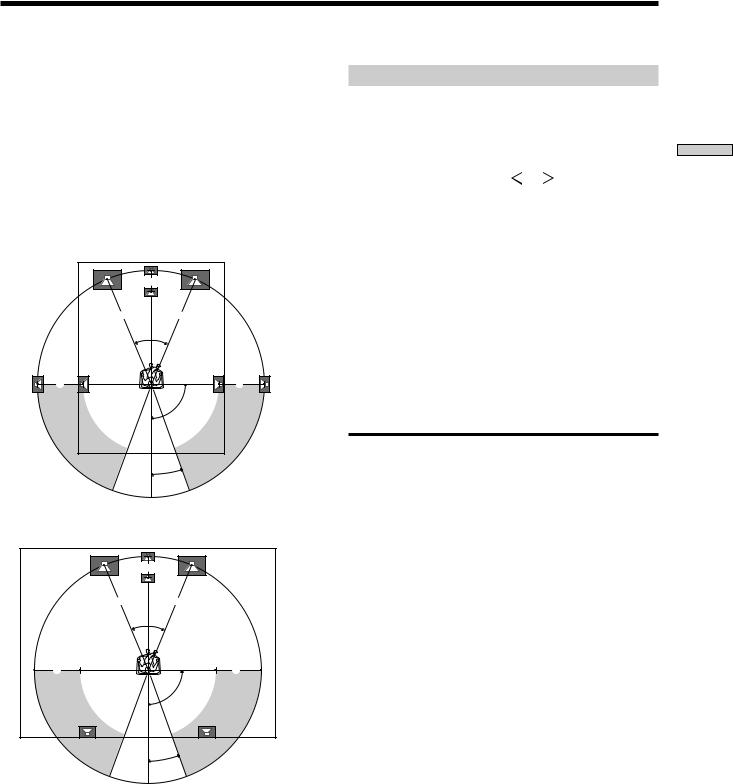
Multi Channel Surround Setup
For the best possible surround sound all speakers should be the same distance from the listening position (A). (However, this unit lets you to place the center speaker up to 5 feet (1.5 meters) closer (B) and the surround speakers up to 15 feet (4.5 meters) closer (C) to the listening position. The front speakers can be placed from 3 to 40 feet (1.0 to 12.0 meters) from the listening position (A).)
You can place the surround speakers either behind you or to the side, depending on the shape of your room (etc.).
When placing surround speakers to your side
B |
A A
45°
C |
C |
|
90° |
20°
When placing the surround speakers behind you
B |
A A
45°
C |
C |
90°
20°
Note
Do not place the center speaker farther away from the listening position than the front speakers.
Specifying the speaker parameters
1Press ?/1 to turn on the receiver.
2Press SET UP.
3 Press the cursor buttons ( or ) to select the parameter you want to adjust.
4Turn the jog dial to select the setting you want.
The setting is stored automatically.
5Repeat steps 3 and 4 until you have set all of the parameters that follow.
z Normal speaker and Micro Satellite speaker
Choose NORM. SP. if you’re using normal speakers and MICRO SP. if you’re using Micro Satellite speakers. If you choose NORM. SP., you can adjust the speaker size and the sub woofer selection as mentioned below. However, if you choose MICRO SP., the speaker size and the sub woofer selection has been configurated as follows:
Speakers |
Settings |
Front |
SMALL |
|
|
Center |
SMALL |
|
|
Surround |
SMALL |
|
|
Woofer |
YES |
|
|
You cannot change the configuration if you choose MICRO SP.
For STR-K502, the speaker size and sub woofer selection has been preset to MICRO SP. according to the supplied speaker system. If you change the speaker system, choose NORM. SP. to adjust the speaker size and sub woofer selection.
The setting for Micro Satellite speaker (MICRO SP.) has been programmed to optimize the sound balance. If you use Sony’s Micro Satellite speakers, select MICRO SP. When you use Micro Satellite speaker and the speaker size is set to LARGE, you may not obtain the correct soundstage. The speaker may also be damaged at high volume position.
For STR-DE575, the speaker size and sub woofer selection has been preset to NORM. SP.
The following speaker size setup is applicable for NORM. SP.
Up Hooking
Setting and the Up System Speaker
15

Up Hooking
Setting and the Up System Speaker
Multi Channel Surround Setup
x Front speaker size ( L R )
Initial setting : LARGE
•If you connect large speakers that will effectively reproduce bass frequencies, select “LARGE”. Normally, select “LARGE”.
•If the sound is distorted, or you feel a lack of surround effects when using multi channel surround sound, select “SMALL” to activate the bass redirection circuitry and output the front channel bass frequencies from the sub woofer.
•When the front speaker is set to “SMALL”, the center and surround speakers are also automatically set to “SMALL” (unless previously set to “NO”).
p Center speaker size ( C )
Initial setting : LARGE
•If you connect a large speaker that will effectively reproduce bass frequencies, select “LARGE”. Normally, select “LARGE”. However, if the front speakers are set to “SMALL”, you cannot set the center speaker to “LARGE”.
•If the sound is distorted, or you feel a lack of surround effects when using multi channel surround sound, select “SMALL” to activate the bass redirection circuitry and output the center channel bass frequencies from the front speakers (if set to “LARGE”) or sub woofer. *1
•If you do not connect the center speaker, select “NO”. The sound of the center channel will be output from the front speakers.*2
p Surround speaker size ( SL SR )
Initial setting : LARGE
•If you connect large speakers that will effectively reproduce bass frequencies, select “LARGE”. Normally, select “LARGE”. However, if the front speakers are set to “SMALL”, you cannot set the surround speakers to “LARGE”.
•If the sound is distorted, or you feel a lack of surround effects when using multi channel surround sound, select “SMALL” to activate the bass redirection circuitry and output the surround channel bass frequencies from the sub woofer or other “LARGE” speakers.
•If you do not connect surround speakers, select “NO”.*3
z *1~*3 correspond to the following Dolby Pro Logic modes
*1 NORMAL
*2 PHANTOM
*3 3 STEREO
z About speaker sizes (LARGE and SMALL)
Internally, the LARGE and SMALL settings for each speaker determine whether or not the internal sound processor will cut the bass signal from that channel. When the bass is cut from a channel the bass redirection circuitry sends the corresponding bass frequencies to the sub woofer or other “LARGE” speaker. However, since bass sounds have a certain amount of directionality it best not to cut them, if possible. Therefore, even when using small speakers, you can set them to “LARGE” if you want to output the bass frequencies from that speaker. On the other hand, if you are using a large speaker, but prefer not to have bass frequencies output from that speaker, set it to “SMALL”.
If the overall sound level is lower than you prefer, set all speakers to “LARGE”. If there is not enough bass, you can use the equalizer to boost the bass levels. To adjust the equalizer see page 34.
x Surround speaker position ( SL SR )*
Initial setting : PL. BEHD.
This parameter lets you specify the location of your surround speakers for proper implementation of the Digital Cinema Sound surround modes in the “VIRTUAL” sound fields. Refer to the illustration below.
•Select “PL. SIDE” if the location of your surround speakers corresponds to section A.
•Select “PL. MID” if the location of your surround speakers corresponds to section B.
•Select “PL. BEHD.” if the location of your surround speakers corresponds to section C.
This setting only effects the surround modes in the “VIRTUAL” sound fields.
|
90° |
|
A |
60° |
A |
|
|
|
B |
30° B |
|
CC
20°
*These parameters are not available when “Surround speaker size” is set to “NO”.
16
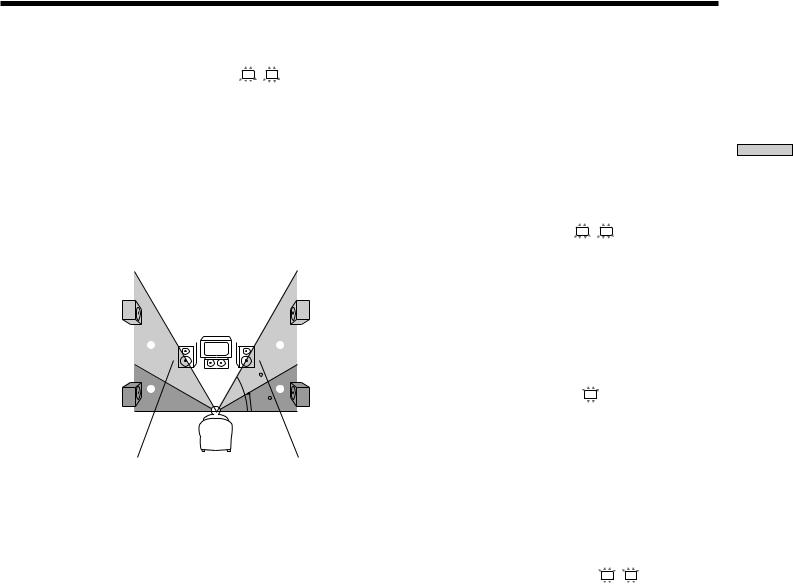
x Surround speaker height ( SL
SL
 SR
SR )*
)*
Initial setting : HGT. LOW
This parameter lets you specify the height of your surround speakers for proper implementation of the Digital Cinema Sound surround modes in the “VIRTUAL” sound fields. Refer to the illustration below.
•Select “HGT. LOW” if the location of your surround speakers corresponds to section A.
•Select “HGT. HIGH” if the location of your surround speakers corresponds to section B.
This setting only affects the surround modes in the “VIRTUAL” sound fields.
B 
 B
B
 60
60
AA
30
*These parameters are not available when “Surround speaker size“ is set to “NO”.
z About the surround speaker position (PL. SIDE, PL. MID and PL. BEHD.)
This setting is designed specifically for implementation of the Digital Cinema Sound modes in the “VIRTUAL” sound fields. With the Digital Cinema Sound modes, speaker position is not as critical as other modes. All of the modes in the “VIRTUAL” sound fields were designed under the premise that the surround speaker would be located behind the listening position, but presentation remains fairly consistent even with the surround speakers positioned at a rather wide angle. However, if the speakers are pointing toward the listener from the immediate left and right of the listening position, the “VIRTUAL” sound fields will not be effective unless the surround speaker position parameter is set to “PL. SIDE”.
Nevertheless, each listening environment has many variables, such as wall reflections, and you may obtain better results using “PL. BEHD” or “PL. MID” if your speakers are located high above the listening position, even if they are to the immediate left and right.
Therefore, although it may result in a setting contrary to the “Surround speaker position” explanation, we recommend that you play back multi channel surround encoded software and listen to the effect each setting has on your listening environment. Choose the setting that provides a good sense of spaciousness and that best succeeds in forming a cohesive space between the surround sound from the surround speakers and the sound from the front speakers. If you are not sure which sounds best, select “PL. BEHD.” and then use the speaker distance parameter and speaker level adjustments to obtain proper balance.
xSub woofer selection
Initial setting : S.W. YES
• If you connect a sub woofer, select “S.W. YES”.
• If you do not connect a sub woofer, select “S.W. NO”. This activates the bass redirection circuitry and outputs the LFE signals from other speakers.
• In order to take full advantage of the Dolby Digital bass redirection circuitry, we recommend setting the sub woofer’s cut off frequency as high as possible.
xFront speaker distance ( L
L 
 R
R  )
)
Initial setting : DIST. 5.0 m (5.0 meter) 16 feet
Set the distance from your listening position to the front (left or right) speaker (A on page 15).
•Front speaker distance can be set in 1 foot (0.1 meter) steps from 3 to 40 feet (1.0 to 12.0 meters).
•If both speakers are not placed an equal distance from your listening position, set the distance to the closest speaker.
x Center speaker distance ( C
C  )
)
Initial setting : DIST. 5.0 m (5.0 meter) 16 feet
Set the distance from your listening position to the center speaker.
•Center speaker distance can be set in 1 foot (0.1 meter) steps from a distance equal to the front speaker distance (A on page 15) to a distance 5 feet (1.5 meters) closer to your listening position (B on page 15).
•Do not place the center speaker farther away from your listening position than the front speakers.
x Surround speaker distance ( SL
SL
 SR
SR )
)
Initial setting : DIST. 3.5 m (3.5 meter) 11 feet
Set the distance from your listening position to the surround (left or right) speaker.
•Surround speaker distance can be set in 1 foot (0.1 meter) steps from a distance equal to the front speaker distance (A on page 15) to a distance 15 feet (4.5 meters) closer to your listening position (C on page 15).
•Do not place the surround speakers farther away from your listening position than the front speakers.
•If both speakers are not placed an equal distance from your listening position, set the distance to the closest speaker.
Up Hooking
Setting and the Up System Speaker
17

Up Hooking
Setting and the Up System Speaker
Multi Channel Surround Setup
z About speaker distances
This receiver allows you to input the speaker position in terms of distance. However, it is not possible to set the center speaker farther away than the front speakers. Also, the center speaker can not be set more that 5 feet (1.5 meters) closer than the front speakers.
Likewise, the surround speakers cannot be set farther away from the listening position than the front speakers. And they can be no more than 15 feet (4.5 meters) closer.
This is because incorrect speaker placement is not conducive to enjoy the surround sound.
Please note that, setting the speaker distance closer than the actual location of the speakers will cause a delay in the output of the sound from that speaker. In other words, the speaker will sound like it is farther away.
For example, setting the center speaker distance 3~6 feet (1~2 m) closer than the actual speaker position will create a fairly realistic sensation of being “inside” the screen. If you cannot obtain a satisfactory surround effect because the surround speakers are too close, setting the surround speaker distance closer (shorter) than the actual distance will create a larger soundstage. (1 foot corresponds to a 1 ms difference.)
Adjusting these parameters while listening to the sound often results in much better surround sound. Give it a try!
Adjusting the speaker volume
Use the remote while seated in your listening position to adjust the volume of each speaker.
Note
This receiver incorporates a new test tone with a frequency centered at 800 Hz for easier speaker volume adjustment.
1Press ?/1 to turn on the receiver.
2Press TEST TONE on the supplied remote.
You will hear the test tone from each speaker in sequence.
3Adjust the volume level so that the volume of the test tone from each speaker sounds the same when you are in your main listening position.
•To adjust the balance of the front right and front left speakers, use the front balance parameter in the LEVEL menu (see page 33).
•To adjust the balance of the surround right and surround left speakers, use the surround balance parameter in the LEVEL menu (see page 33).
•To adjust the volume level of the center speaker, press MENU </> to select the center parameter. Use +/– on the remote to adjust the level.
•To adjust the volume level of the surround speaker, press MENU </> to select the surround parameter. Use +/– on the remote to adjust the level.
4Press TEST TONE on the remote again to turn off the test tone.
Note
The test tone cannot be output when the receiver is set to MULTI CH IN.
z You can adjust the volume level of all speakers at the same time
Rotate MASTER VOLUME on the receiver or press MASTER VOL +/– on the remote.
18
